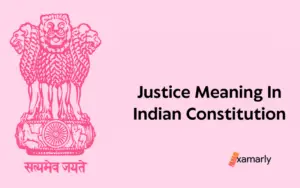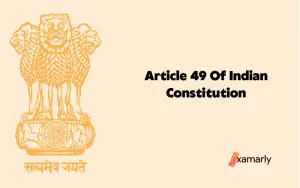We will get to know in detail about the Geography Optional Syllabus For UPSC in this article. The Optional papers for the UPSC CSE mains carry a total of 500 marks. There are two papers in it. Each paper is worth 250 out of a total of 500. The UPSC CSE Mains examination follows the UPSC CSE Preliminary examination. There is a 2-3 month gap between the two stages for the students to prepare well.
A large portion of the syllabus overlaps with the General Studies Paper 1 of the UPSC Preliminary Examination.
Geography Optional Syllabus For UPSC For Mains
The topic-wise list of the Geography Optional syllabus is listed below :
Geography Optional Paper 1
Optional paper 1 is mainly divided into two parts, Physical Geography, and Human Geography. Both these parts are quite important from the point of view of the Prelims examination.
Physical Geography (Part 1)
Unit 1: Geomorphology
The study of landforms, their formation, and processes,
sediments on the Earth’s surface (and other planets) is known as geomorphology.
The sub-topics are listed below :
- Factors controlling landform development
- Endogenetic and Exogenetic Forces
- Origin and Evolution of the Earth’s Crusts
- Fundamentals of Geomagnetism
- Physical Conditions of the Earth’s interior
- Geosynclines
- Continental drift
- Isostasy
- Plate Tectonics
- Recent views on mountain building
- Volcanicity
- Earthquakes and Tsunamis
- Concepts of Geomorphic cycles and Landscape development
- Denudation Chronology
- Channel Morphology
- Erosion Surfaces
- Slope Development
- Applied Geomorphology
- Geomorphology, economic geology, and environment
Unit 2: Climatology
The scientific study of climate is known as climatology or climate science. It is defined as the weather’s average over a certain period of time.
The sub-topics are listed below :
- Temperature and Pressure belts of the World
- Heat Budget of the Earth
- Atmospheric Circulations
- Atmospheric stability and instability
- Planetary and local winds
- Monsoons and jet streams
- Air masses and Fronts
- Temperate and tropical cyclones
- Types and distribution of precipitation
- Weather and Climate
- Koppen Thornthwaite’s and Trewartha’s classification of world climate
- Hydrological cycle
- Global climatic change
- Role and response of man in climatic changes
- Applied climatology
- Urban climate.
Unit 3: Oceanography
Oceanography is a branch of science that studies the oceans, including the
their depth and extent, as well as the physics and chemistry of their
waterways, marine biology, and resource extraction from them.
The sub-topics are listed below :
- Bottom topography of the Atlantic, Indian, and Pacific Oceans
- Temperature and salinity of the oceans
- Heat and salt budgets
- Ocean deposits
- Waves, currents, and tides
- Marine resources
- Biotic, mineral, and energy resources
- Coral reefs coral bleaching
- Sea-level changes
- Law of the sea
- Marine pollution
Unit 4: Biogeography
The study of the distribution of species and ecosystems in
geographic space and through geological time is termed Biogeography.
The sub-topics are listed below :
- Genesis of soils
- Classification and distribution of soils
- Soil profile
- Soil erosion
- Degradation and conservation
- Factors influencing world distribution of plants and animals
- Problems of deforestation and conservation measures
- Social forestry, Agro-forestry
- Wildlife
- Major gene pool centers
Unit 5: Environmental Geography
The spatial aspects of interactions between humans and the natural world is termed Environmental Geography.
The sub-topics are listed below:
- Principle ecology
- Human ecological adaptations
- Influence of man on ecology and environment
- Global and regional ecological changes and imbalances
- Ecosystem management and conservation
- Environmental degradation, management, and conservation
- Biodiversity and sustainable development
- Environmental policy
- Environmental hazards and remedial measures
- Environmental education and legislation
Human Geography (Part 2)
Unit 1: Perspectives In Human Geography
- Areal differentiation
- Regional synthesis
- Dichotomy and dualism
- Environmentalism
- Quantitative revolution and locational analysis
- Radical, behavioral, human, and welfare approaches
- Languages, religions, and secularisation
- Cultural regions of the world
- Human development index
Unit 2: Economic Geography
- World economic development: measurement and problems
- World resources and their distribution
- Energy crisis
- The limits to growth
- World agriculture: a typology of agricultural regions
- Agricultural inputs and productivity
- Food and nutrition problems
- Food security
- Famine: causes, effects, and remedies
- World Industries: locational patterns and problems
- Patterns of world trade
Read Also – Geography Optional For UPSC
Unit 3: Population And Settlement Geography
- Growth and distribution of world population
- Demographic attributes
- Causes and consequences of migration
- Concepts of over-under-and optimum population
- Population theories, world population problems and policies, Social well-being, and quality of life
- Population as social capital
- Types and patterns of rural settlements
- Environmental issues in rural settlements
- Hierarchy of urban settlements
- Urban morphology
- Concept of primate city and rank-size rule
- Functional classification of towns
- Sphere of urban influence
- Rural-urban fringe
- Satellite towns
- Problems and remedies of urbanization
- Sustainable development of cities
Unit 4: Regional Planning
- Concept of a region
- Types of regions and methods of regionalization
- Growth centers and growth poles
- Regional imbalances
- Regional development strategies
- Environmental issues in regional planning
- Planning for sustainable development
Unit 5: Models, Theories, And Laws In Human Geography
- Systems analysis in Human geography
- Malthusian, Marxian, and demographic transition models
- Central Place theories of Christaller and Losch
- Perroux and Boudeville
- Von Thunen’s model of agricultural location
- Weber’s model of industrial location
- Rostov’s model of stages of growth
- Heartland and Rimland theories
- Laws of international boundaries and frontiers
Geography Optional Paper 2
Paper 2 of the optional subject deals with the Geography of India.
The topics are listed below:
Unit 1: Physical Setting
- Space relationship of India with neighboring countries
- Structure and relief
- Drainage systems and watersheds
- Physiographic regions
- Mechanism of Indian monsoons and rainfall patterns
- Tropical cyclones and western disturbances
- Floods and droughts
- Climatic regions
- Natural vegetation
- Soil types and their distributions
Unit 2: Resources
- Land resources, surface and groundwater, energy, minerals, marine, and biotic resources, Forest and wildlife resources and their conservation
- Energy crisis.
Unit 3: Agriculture
- Infrastructure: irrigation, seeds, fertilizers, power
- Institutional factors; land holdings, land tenure, and land reforms
- Cropping pattern, agricultural productivity, agricultural intensity, crop combination, land capability
- Agro and social-forestry
- Green revolution and its socio-economic and ecological implications
- Significance of dry farming
- Livestock resources and the white revolution
- Aquaculture
- Sericulture, Agriculture, and poultry
- Agricultural regionalization
- Agro-climatic zones
- Agro- ecological regions
Unit 4: Industry
- Evolution of industries
- Locational factors of cotton, jute, textile, iron and steel, aluminum industries, fertilizer, paper, chemical industries and pharmaceutical, automobile, cottage, and agro-based industries
- Industrial houses and complexes including public sector undertakings
- Industrial regionalization
- New industrial policy
- Multinationals and liberalization
- Special Economic Zones
- Tourism including ecotourism
Unit 5: Transport, Communication, And Trade
- Road, railway, waterway, airway, and pipeline networks and their complementary roles in regional development
- The growing importance of ports on national and foreign trade
- Trade balance
- Trade Policy
- Export processing zones
- Developments in communication and information technology and their impacts on the economy and society
- Indian space program
Unit 6: Cultural Setting
- Historical Perspective of Indian Society
- Racial linguistic and ethnic diversities
- Religious minorities
- Major tribes, tribal areas, and their problems
- Cultural regions
- Growth, distribution, and density of the population
- Demographic attributes: sex ratio, age structure, literacy rate, workforce, dependency ratio, longevity
- Migration (inter-regional, intraregional and international) and associated problems
- Population problems and policies
- Health indicators
Unit 7: Settlements
- Types, patterns, and morphology of rural settlements
- Urban developments
- Morphology of Indian cities
- Functional classification of Indian cities
- Conurbations and metropolitan region
- Urban sprawl
- Slums and associated problems
- Town planning
- Problems of urbanization and remedies
Unit 8: Regional Development And Planning
- Experience of regional planning in India
- Five Year Plans
- Integrated rural development programs
- Panchayati Raj and decentralized planning
- Command area development
- Watershed management
- Planning for the backward area, desert, drought-prone, hill tribal area development
- Multi-level planning
- Regional planning and development of island territories
Unit 9: Political Aspects
- Geographical basis of Indian federalism
- State reorganization
- The emergence of new states
- Regional consciousness and inter-state issues
- The international boundary of India and its related issues
- Cross-border terrorism
- India’s role in world affairs
- Geopolitics of South Asia and Indian Ocean realm.
Unit 10: Contemporary Issues
- Ecological issues: Environmental hazards: landslides, earthquakes, Tsunamis, floods and droughts, epidemics
- Issues related to environmental pollution
- Changes in patterns of land use
- Principles of environmental impact assessment and environmental management;
- Population explosion and food security
- Environmental degradation
- Deforestation, desertification, and soil erosion
- Problems of agrarian and industrial unrest
- Regional disparities in economic development
- Concept of sustainable growth and development
- Environmental awareness
- Linkage of river
- Globalization and the Indian economy
*Candidates of the UPSC IAS Mains Exam need to answer a compulsory Map Question pertinent to the area of study covered by this paper i.e. Paper 2.
Related – Important Topics of Geography for UPSC
FAQs
List some of the reference books for Geography optional papers 1& 2.
Some of the reference books are listed below
Physical Geography by Savinder Singh
Human Geography by Majid Hussain
Indian Geography by D R Khullar
What is the Geography syllabus for UPSC Prelims Examination?
Majority portions of Paper 2 and parts of Paper 1 of the mains examination overlap with the Prelims syllabus of UPSC Mains.






